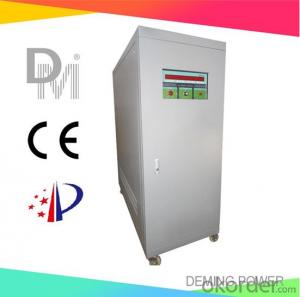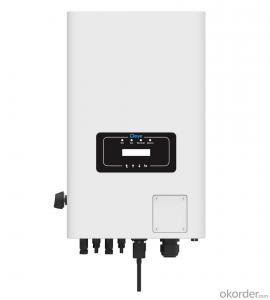30kW 33kW 36kW 40kW Three Phase On-Grid Solar Inverter
- Loading Port:
- China main port
- Payment Terms:
- TT or LC
- Min Order Qty:
- 30 unit
- Supply Capability:
- 500 unit/month
OKorder Service Pledge
OKorder Financial Service
You Might Also Like
Specification
CNBM 30kW 33kW 36kW 40kW Three Phase On-Grid Solar Inverter PV Solution
XG30kW-40kW Three Phase On-Grid Solar Inverter
XG30KTR | XG33KTR | XG36KTR | XG40KTR | |
Input(DC) | ||||
Max. Input Power | 48 kW | 52.8 kW | 57.6 kW | 64 kW |
Max. Input Voltage | 1100V | |||
Start Voltage | 250V | |||
Rated Input Voltage | 600V | |||
Full-load MPP Voltage Range | 500V-800V | |||
MPPT Voltage Range | 200V-1000V | |||
Number of MPP Trackers | 3 | 4 | ||
String per MPPT | 2 | |||
Max.Current per MPPT | 26A | |||
Max.Short Circuit Current per MPPT | 32A | |||
Output(AC) | ||||
Max. Output Current | 48.3 A | 53 A | 57.8 A | 64.3 A |
Rated Output Power | 30 kW | 33 kW | 36 kW | 40 kW |
Max. Output Power | 33.3 kVA | 36.6 kVA | 39.6 kVA | 44 kVA |
Rated Grid Frequency | 50 Hz / 60 Hz | |||
Rated Grid Voltage | 230Vac / 400Vac, 3L / N / PE | |||
Power Factor | >0.99 (0.8 leading~0.8 lagging) | |||
THDi | <3% (Rated Power) | |||
Efficiency | ||||
Max. Efficiency | 98.60% | |||
European Efficiency | 98.50% | |||
MPPT Efficiency | 99.90% | |||
Protection | ||||
DC reverse polarity protection | Yes | |||
Anti-Islanding protection | Yes | |||
AC short circuit protection | Yes | |||
Residual current monitoring unit | Yes | |||
Insulation resistance monitoring | Yes | |||
Ground fault monitoring | Yes | |||
Grid monitoring | Yes | |||
PV string monitoring | Yes | |||
Surge protection | Type II | |||
AFCI protection | Optional | |||
Communication | ||||
Display | LED / LCD / WiFi+App | |||
Communication | Standard:RS485 Optional:WiFi / GPRS / Ethernet | |||
Standard Compliance | ||||
Grid Connection Standards | IEC 61727, IEC 62116, IEC 60068, IEC 61683, VDE-AR-N 4110:2018, VDE-AR-N 4105:2018, VDE-AR-N 4120:2018, EN 50549, AS/NZS 4777.2:2020, CEI 0-21, VDE0126-1-1/A1 VFR 2014,UTE C15-712-1:2013, DEWA DRRG, NRS 097-2-1, MEA/PEA, C10/11, G98/G99 | |||
Safety/EMC | IEC 62109-1:2010, IEC 62109-2:2011, EN 61000-6-2:2005, EN 61000-6-3:2007/A1:2011 | |||
General Data | ||||
Dimensions (W*H*D) | 600 x 430 x 230 mm | |||
Weight | 30 kg | 32 kg | ||
Operating Temperature Range | -30° C ~ +60° C | |||
Cooling Method | Smart Cooling | |||
Protection Degree | IP66 | |||
Max. Operating Altitude | 4000 m | |||
Relative Humidity | 0 ~ 100% | |||
Topology | Transformerless | |||
Night Power Consumption | < 1 W | |||
MARKETING & SERVICE NETWORK
CNBM global sales team provides customers with professional and efficient pre-sale,
in sale and after-sale services, and enhances the added value of the brand with high-quality services.
Products Details:
High voltage protection Over load protection
Battery reverse connected protection Dust-proof
Low voltage protection Overheating protection
Output short-circuit protection Insect prevention






- Q: Can a solar inverter be connected to a battery storage system?
- Yes, a solar inverter can be connected to a battery storage system. This allows excess solar energy generated during the day to be stored in the batteries and used later when there is no sunlight, providing a reliable source of power.
- Q: Can a solar inverter be upgraded or expanded?
- Yes, a solar inverter can be upgraded or expanded. Upgrades may involve adding new features or improving the efficiency of the existing inverter. Expansion typically refers to increasing the capacity of the inverter to accommodate additional solar panels. However, the extent to which an inverter can be upgraded or expanded varies depending on the specific model and manufacturer.
- Q: Can a solar inverter be controlled remotely?
- Indeed, remote control of a solar inverter is possible. Numerous contemporary solar inverters are furnished with integrated communication capabilities like Wi-Fi or Ethernet connectivity, granting the ability to monitor and control them from a distance. Users can access and manage their solar inverters from any location with an internet connection through a web-based interface or a dedicated mobile app. The remote control features typically encompass performance monitoring, settings adjustment, and issue troubleshooting. This remote control functionality provides solar system owners with convenience and flexibility, empowering them to maximize energy production and efficiently manage their systems.
- Q: Can a solar inverter be used in areas with high dust and dirt accumulation?
- Yes, it is possible to use a solar inverter in areas where there is a high accumulation of dust and dirt. However, it is important to take specific precautions and maintenance measures to guarantee its proper operation. Over time, dust and dirt can build up on the surface of the solar panels, causing a decrease in their efficiency. This can also have an impact on the performance of the solar inverter, as it relies on the energy produced by the solar panels. To minimize the impact of dust and dirt, it is essential to regularly clean the solar panels. This can be accomplished by using a gentle brush or sponge along with a mild detergent mixed with water. It is important to avoid using abrasive materials or applying excessive water pressure, as this may cause damage to the panels. Additionally, installing the solar panels at an angle and orienting them towards the sun can aid in reducing the accumulation of dust and dirt. Furthermore, some solar inverters are designed with built-in protection against dust and dirt. These inverters typically have IP65 or higher ratings, which indicates that they are dust-resistant and capable of withstanding water jets. Opting for such inverters can provide an extra layer of protection against the negative effects of dust and dirt accumulation. Overall, while it is possible to use a solar inverter in areas with high dust and dirt accumulation, regular maintenance and proper cleaning of the solar panels are crucial to ensure optimal performance and longevity of the system.
- Q: How does a grid-tied solar inverter work?
- A grid-tied solar inverter works by converting the direct current (DC) electricity produced by solar panels into alternating current (AC) electricity that can be used to power homes or businesses. It synchronizes the AC electricity it generates with the electrical grid, allowing excess electricity to be sent back to the grid for credits or future use. This inverter also monitors the grid's voltage and frequency to ensure the solar system operates safely and efficiently.
- Q: How does a solar inverter handle variations in solar panel tilt and orientation?
- A solar inverter handles variations in solar panel tilt and orientation by adjusting the power output to maximize the energy harvest. It continuously monitors the performance of the solar panels and adjusts the voltage and current levels to optimize the conversion of sunlight into usable electricity. This allows the inverter to accommodate changes in tilt and orientation, ensuring the system operates at its highest efficiency regardless of the panel position.
- Q: Can a solar inverter be used with a smart home system?
- Yes, a solar inverter can be used with a smart home system. In fact, integrating a solar inverter with a smart home system allows for better monitoring, control, and optimization of the solar energy production and consumption in the home. This integration enables homeowners to track their energy usage, maximize self-consumption, and even automate certain appliances or systems based on the availability of solar power.
- Q: How does a solar inverter handle voltage and frequency regulation?
- A solar inverter handles voltage and frequency regulation by converting the direct current (DC) generated by solar panels into alternating current (AC) that matches the utility grid's voltage and frequency. It achieves voltage regulation by constantly monitoring the grid voltage and adjusting the inverter's power output accordingly. Frequency regulation is achieved by synchronizing the inverter's output frequency with the grid frequency, ensuring a stable and consistent power supply.
- Q: How does a solar inverter handle electromagnetic interference?
- A solar inverter handles electromagnetic interference by incorporating various filtering techniques and components to minimize the impact of electromagnetic interference on its operation. This includes using electromagnetic compatibility (EMC) filters, shielding, and proper grounding techniques. These measures help to reduce electromagnetic emissions from the inverter and also protect it from external electromagnetic disturbances, ensuring reliable and efficient operation.
- Q: How does a solar inverter affect the value of a property?
- A solar inverter can positively affect the value of a property by making it more attractive to potential buyers. It increases the property's energy efficiency and reduces electricity costs, which can be a significant factor for buyers looking for sustainable and cost-effective homes. Additionally, having a solar inverter installed demonstrates the property's commitment to renewable energy, which can be appealing to environmentally-conscious buyers.
Send your message to us
30kW 33kW 36kW 40kW Three Phase On-Grid Solar Inverter
- Loading Port:
- China main port
- Payment Terms:
- TT or LC
- Min Order Qty:
- 30 unit
- Supply Capability:
- 500 unit/month
OKorder Service Pledge
OKorder Financial Service
Similar products
Hot products
Hot Searches
Related keywords




























